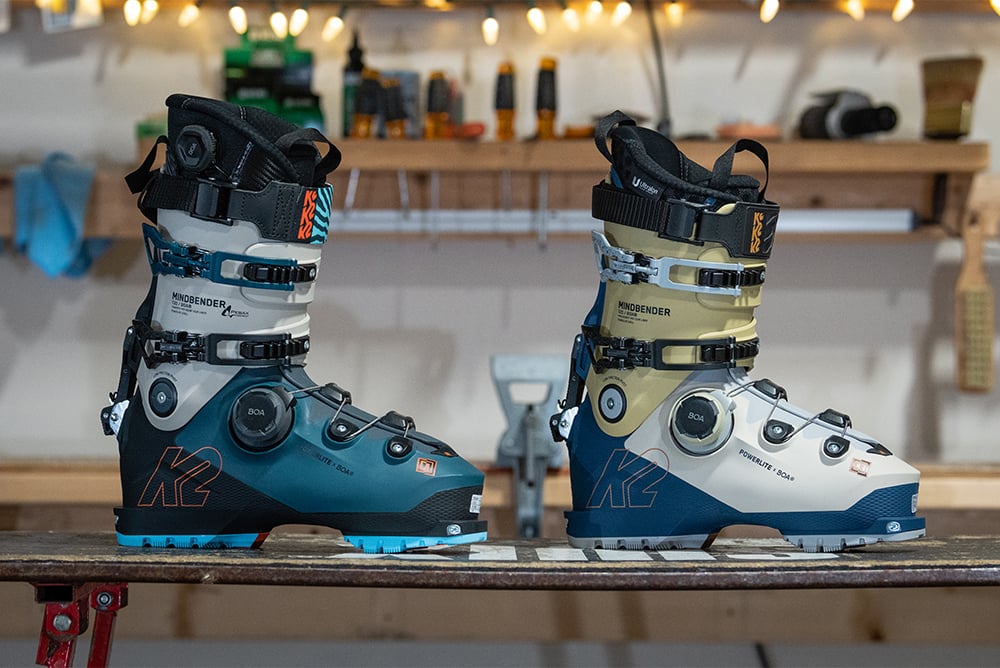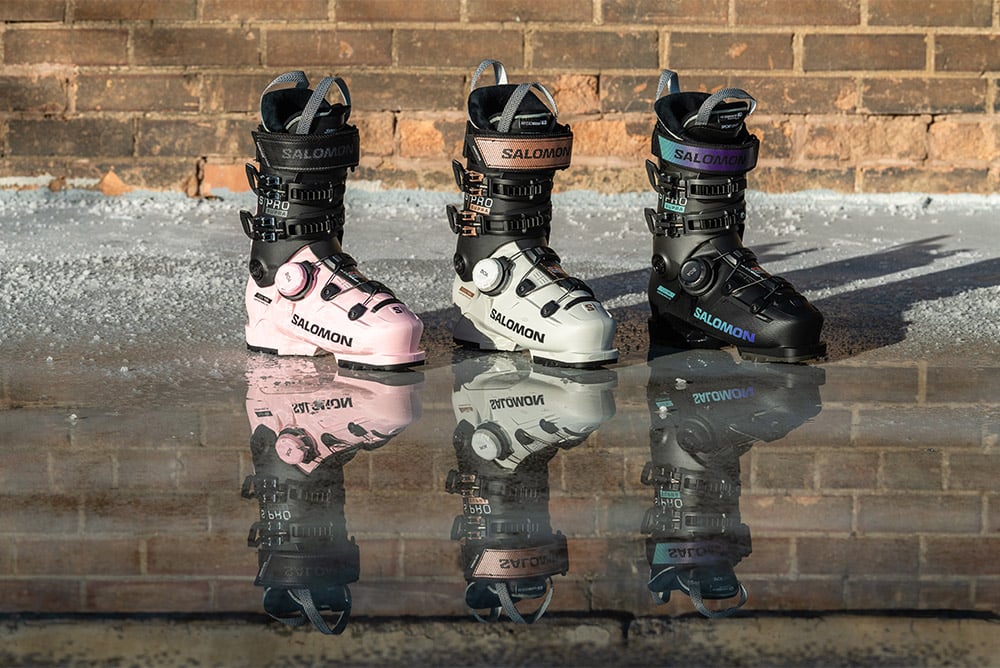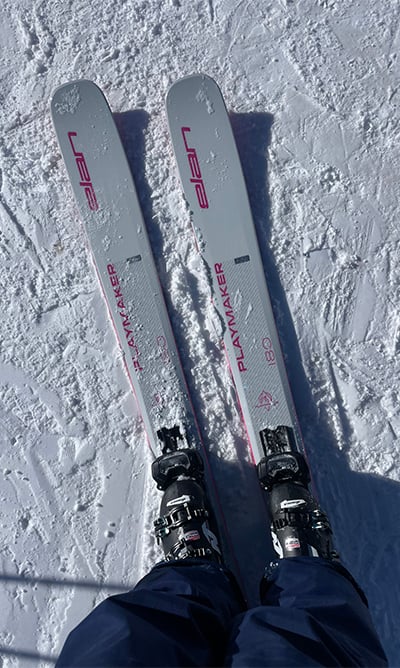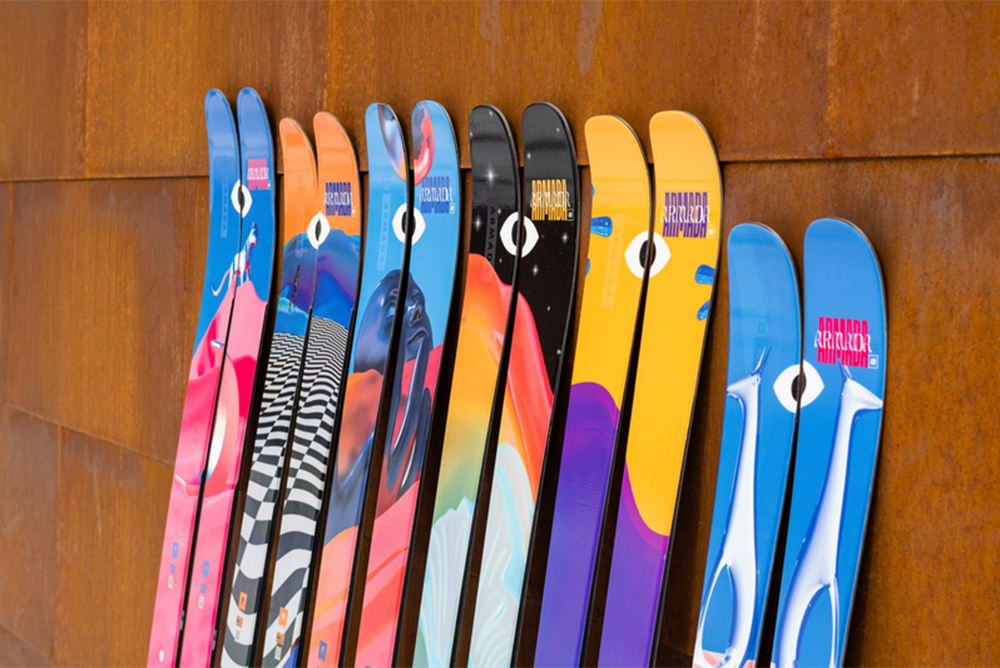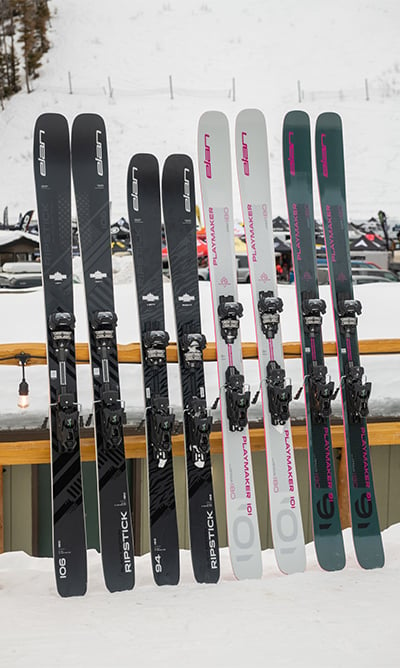2024 Ski Trends:
BOA Boots & All-Mountain Freestyle Skis
By: Sammi Bushman, Product Content Writer | March 7, 2023
The ski industry is bubbling over with innovations and technology for the upcoming season, and BOA ski boots are dominating the conversation. We expect BOA tech to be a major component in the industry going forward, and can’t wait to see what brands bring to the table. On the ski front, all-mountain freestyle skis are making a comeback. These 90-110mm skis offer the best of both worlds: a playful park flex in a capable all-mountain package. We got our hands on as much new product as possible this winter and found out what makes the latest generation of BOA boots and all-mountain freestyle skis so special.
BOA Boots
Ski brands are looking towards BOA technology in a big way next year, representing the continuing innovation of the outdoor industry while elevating technology available to the average skier. In the 2023/24 season, four major ski boot manufacturers debut a BOA boot: Atomic, Salomon, K2, and Fischer.
On the new boots, a burly BOA mechanism replaces the two buckles that traditionally sit over the forefoot, acting like a lace that closes the space over the top of your foot. In theory, the advantage of BOA boils down to a more even distribution of pressure around the foot, which can be particularly helpful if traditional buckles tend to crush your instep. They also make overlap boots more accessible to people with different body types by providing a more adjustable width, and a closer fit around the forefoot translates to improved precision when riding.

Bootfitters are pumped about BOA boots, and for good reason. We sat down with senior evo Bootfitter, Greg Louie, to learn more about the new technology.
First things first, how do the new BOA boots fit?
The BOA boots fit like their buckle compatriots in every case that I know of. Even though boot manufacturers have to build an entirely new shell to accommodate the BOA, they have copied the fit of an existing boot when doing so. If you fit well in an Atomic Hawx Ultra, for example, the new Hawx Ultra XTD BOA will fit the same.
What is different / unique about the new BOA system?
The new BOA is an entirely new design, much beefier and easier to service than what you have seen in snowboard boots or light AT boots. It’s both taller and larger in diameter, which is both good (in terms of adjustment) and bad (in terms of susceptibility to impacts). There is a thick steel cable zig-zagging over the instep of the boot, and the routing is all external which should aid in repairs.
Whereas all previous BOA systems tightened with a clockwise twist and released by pulling up on the knob, the new system tightens clockwise on the right boot and counterclockwise on the left. One other cool thing is that you can dial back the tension incrementally by reversing the direction of the knob, it’s not the all-or-nothing release you get by pulling up on a traditional BOA.

2023/24 K2 Recon BOA dial

2023/24 K2 Recon BOA cable

2023/24 Salomon S/Pro Supra BOA 105
Working in a boot lab and seeing the number of BOA repairs we do per week put me firmly in the “no-BOA” camp at first, but that changed after trying on and having a chance to ski in a BOA boot. For my much wider than average foot with a medium tall instep, the BOA version was much more comfortable over the top of my forefoot.

evo Seattle Bootfitter, Greg Louie
Have your impressions changed since getting your hands (and feet) on the tech?
I’m a traditionalist when it comes to gear, particularly boots, still skiing much of the time in a barely-modified plug race boot. Working in a boot lab and seeing the number of BOA repairs we do per week put me firmly in the “no-BOA” camp at first, but that changed after trying on and having a chance to ski in a BOA boot. For my much wider than average foot with a medium tall instep, the BOA version (I was able to ski in identical prototype shells with buckles and BOA back to back) was much more comfortable over the top of my forefoot with no performance negatives.
For now, brands are offering both traditional buckle and BOA versions of some boots. Will this change the way you fit boots?
Bootfitting shouldn’t change all that much. The most important thing is getting a customer into the right size, last and flex and BOA won’t be available in every instance. If you love the Salomon S/Pro Alpha and have a narrow foot with a thin ankle, go ahead and get it next season – BOA will only be available in the roomier S/Pro last for ’23-‘24. With Atomic, the opposite is true, they’ll debut the BOA on narrow Ultra boots first with BOA for the Hawx Prime boots coming in 2024/25.
I think for most average feet the BOA will distribute pressure more evenly over the instep without concentrating pressure over the top of the forefoot and instep. There has already been some feedback among beta testers that the BOA works better for wider feet and sometimes doesn’t quite get tight enough for narrower ones, and also that the BOA seems to work better with softer shells than stiffer ones, so if you’re at the high end of the flex index spectrum I’d be skeptical (you won’t find any 150 flex plug boots with Boa anyway).
All Mountain Freestyle Skis
All-mountain freestyle skis are back in style, with some well established names being updated for a new generation. The new Line Chronic 94 & 101, Bacon 108, and the redesign of the Armada ARV and ARW series embody the desire of modern riders to do as much as they can with what’s under their feet. Elan also sees the value of tapping into this style of riding, debuting their first true twin-tips next season, the Playmaker 91 and 101.
Boasting mid-fat waist widths between 90 and 110mm, these skis typically feature a softer flex and a park-friendly twin-tip design. Their versatile geometry and added durability makes them great for ripping around the whole mountain with a more playful style. While their progressive mount points can take some getting used to if you come from a more directional background, all-mountain freestyle skis are generally easier to maneuver, which makes them appeal to a wide audience of riders. Everyone from progressing intermediates to those hucking backflips off the top chair can enjoy the versatile and playful personality of these skis.

We spoke with evo Ski Buyer, Jordan Berde, to learn more about how the market continues to evolve.
What trends are we seeing with all-mountain freestyle skis, and how have these evolved?
For the past several years, the industry skewed towards a ski that felt more planted, damp, and stable. Most brands experimented with aluminum alloys (titanal) in their construction. The result? Skis that wanted to bomb down mountains at high speed - metal in skis was everywhere and nearly unavoidable. The trade-off of that planted, damp ski? Losing out on the playfulness we yearn for when we’re out on the slopes. Not only that, but I’m getting older, and a more forgiving ski that doesn’t punish me for getting in the backseat keeps the stress levels low and the fun meter high. Ski manufacturers have found the perfect balance when it comes to using metal in skis – enough to make it stable underfoot but absent in the tips and tails to give it that playful, light feeling when you’re in the bumps or soft snow. Not only have we seen the construction change, but also the shape. Manufacturers are dialing in the rocker profiles as well – slightly turned tails (tail rocker) seems to be the new norm, allowing an easy-to-release tail in softer snow and variable conditions.
Ski manufacturers have found the perfect balance when it comes to using metal in skis – enough to make it stable underfoot but absent in the tips and tails to give it that playful, light feeling when you’re in the bumps or soft snow.
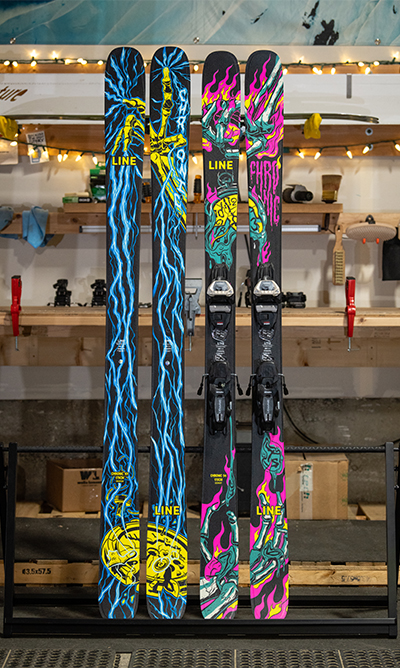 Line Chronic 101 / 94
Line Chronic 101 / 94
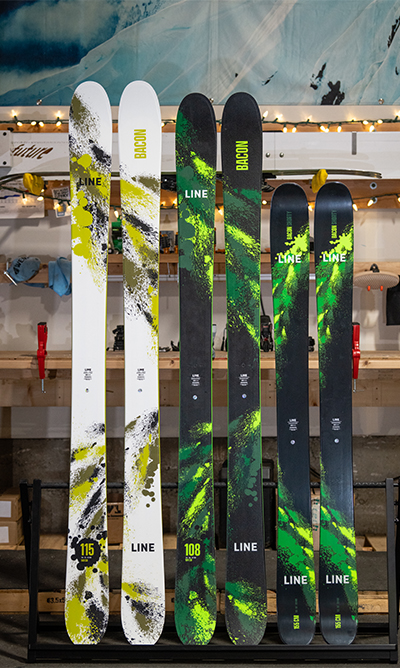 Line Bacon 115 / 108 / Shorty
Line Bacon 115 / 108 / Shorty

evo Ski Buyer, Jordan Berde
What are you most excited about going forward?
More inclusive sizing! New for this year is the Line Bacon (now in two waist widths), the Elan Playmaker, and the Armada ARV 100. In previous years, you’d be hard pressed to find similar skis in sizes shorter than 175cm, especially in the first year they were released. Turns out that’s not the case this year! All three of these new models come in shorter sizes for skis of all genders – the Bacon down to 166cm, the ARV 100 down to 158cm, and the Playmaker down to 156cm. Other skis will see extended size runs as well, such as the Faction La Machine, the Line Blend, the Blizzard Rustler/Sheeva, and the K2 Mindbender line.
Unisex lines! What’s important when choosing a ski length? Your height, weight, and ability level. Skis know NO gender! Men, women, non-binary folks – PEOPLE, people – come in all shapes and sizes. Several brands like DPS are unisex across their entire line – offering two different colorways. You’ll probably remember Fischer’s Ranger ski that came in pink or Armada’s ARW 106 UL – although more feminine-leaning, these skis sold best in the longer lengths! Both Blizzard and Armada introduced touring-oriented freestyle skis (the Hustle and Locator, respectively) that were unisex and came down into the 150s. We’ve since opted to merchandise our stores with this idea in mind – skis are separately out by length and brand. Gone are the days of separating the Ws section. I hope to see this trend continue to spread throughout the industry.
An extended color palette! There are more diverse color options than ever before – no more shrink-it-and-pink-it! Some of the best colorways are on Ws skis – such as across the Armada ARW line, the Salomon QST line, and the Rossignol Black Ops line. More feminine colorways are showing up on men’s skis too – such as with the QST 106 for next year. Purple is hot, fellas.

